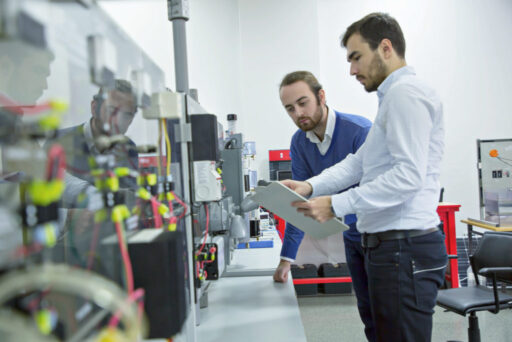Even during the development of initial ideas for a new product, it becomes clear which requirements it must fulfil in order to meet its functionality. But when and how are the requirements best tested? Is it not more than enough to test the product as a final prototype at the end?

Blog: Why testing is so important throughout the product development process
Why we test during development
At Mechatronic GmbH, testing is integrated into development projects right from the start. But what exactly does that mean?
Once the initial requirements for the product have been defined, test strategies are drawn up. These define the scope, acceptance criteria and methods of testing. The aim of the tests is to achieve the desired quality of the product.
The type of test differs depending on the product and prototype. Defining the objective of the respective prototype helps to set milestones in the project. Functionalities that the prototype must fulfil are defined here. As the prototype matures, the requirements for the product increase. The test plan therefore becomes more and more detailed.
Individual components are tested, the interaction of selected components is tested or entire system tests are simulated. We categorise our test plan for verification into:
- Hardware tests (mechanics, electronics)
- Software tests
- System tests

Advantages of testing during development
Testing during the entire product development process offers a number of advantages. These include:
- Innovative way of working: Right from the start, findings from testing can be incorporated into the design of the product. Product development is thus positively influenced by new ideas and concepts.
- No missing or insufficient testability of the system, as product requirements and test strategies are developed hand in hand
- Better error analysis: traceability and verifiability of test activities
- High customer satisfaction: New customer requirements can be better considered and evaluated.
- Risk minimisation: Risks can be identified at an early stage.
- High product quality: Knowledge gained during testing can optimise the product.
Conclusion: Testing is agile and essential
It is important that development-accompanying testing is an agile process. This is particularly important if there is close cooperation with the customer and regular coordination takes place. This is because customer requests and findings from development mean changes. Various prototypes are therefore built.
In addition, risks – i.e. the probability that an undetected error will have a negative impact on the product – can be easily assessed as test results are available for each project phase. By testing at different stages of development, risks can be recognised at an early stage.
Overall, it can be seen that the verification of a product by means of development-accompanying testing is a smooth, usually almost formal conclusion to a project.